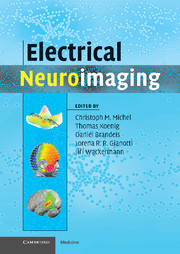Book contents
- Frontmatter
- Contents
- List of contributors
- Preface
- 1 From neuronal activity to scalp potential fields
- 2 Scalp field maps and their characterization
- 3 Imaging the electric neuronal generators of EEG/MEG
- 4 Data acquisition and pre-processing standards for electrical neuroimaging
- 5 Overview of analytical approaches
- 6 Electrical neuroimaging in the time domain
- 7 Multichannel frequency and time-frequency analysis
- 8 Statistical analysis of multichannel scalp field data
- 9 State space representation and global descriptors of brain electrical activity
- 10 Integration of electrical neuroimaging with other functional imaging methods
- Index
Preface
Published online by Cambridge University Press: 15 December 2009
- Frontmatter
- Contents
- List of contributors
- Preface
- 1 From neuronal activity to scalp potential fields
- 2 Scalp field maps and their characterization
- 3 Imaging the electric neuronal generators of EEG/MEG
- 4 Data acquisition and pre-processing standards for electrical neuroimaging
- 5 Overview of analytical approaches
- 6 Electrical neuroimaging in the time domain
- 7 Multichannel frequency and time-frequency analysis
- 8 Statistical analysis of multichannel scalp field data
- 9 State space representation and global descriptors of brain electrical activity
- 10 Integration of electrical neuroimaging with other functional imaging methods
- Index
Summary
In 1929, Hans Berger, the founding father of electroencephalography (EEG), described EEG as a “window into the brain,” because EEG appeared to be a sensitive indicator of mental states. Eighty years later, recording and analysis methods exist that have made EEG a widespread and validated tool to observe the spatial and temporal dynamics of brain network activity during a large variety of mental states and processes in a completely noninvasive fashion. This has been made possible by significant technological advances that now allow the simultaneous recording of an EEG from a large number of electrodes at a high sampling rate, and the application of space-domain oriented approaches to the analysis of these recordings. This book gives an overview of these methods. Illustrated by various examples from experimental and clinical studies, the book is a tutorial on how to use EEG as a modern functional imaging method with the advantage of directly recording neuronal activity with millisecond temporal resolution, an approach called electrical neuroimaging.
Electrical neuroimaging has enormous potential if properly applied, but it can also easily lead to erroneous conclusions if its basic principles are not properly understood. This book intends to give a comprehensive introduction to the basics of multichannel recording of EEG and event-related potential (ERP) data, and to spatio-temporal analysis of the potential fields. All chapters include practical examples from clinical and experimental research.
- Type
- Chapter
- Information
- Electrical Neuroimaging , pp. ix - xPublisher: Cambridge University PressPrint publication year: 2009



